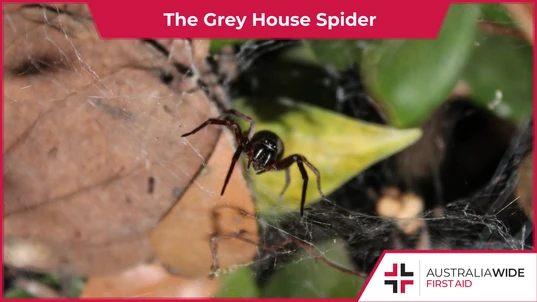The Grey House Spider Explained

Bites and Stings

Though Grey house spiders can live in a variety of habitats, they prefer to build their tangled, ladder-like webs in and around houses on the eastern side of Australia. Like most House spiders, their bites can cause moderate to severe local symptoms.
Endemic to eastern Australia, the Grey house spider (Badumna longinqua) can live in a variety of environments ranging from grasslands to riverside forests. However, as their name suggests, they prefer to build webs in and around houses. These tiny arachnids can also pack a mean bite resulting in localised pain and swelling. Continue reading for more information on the Grey house spider, where you are likely to encounter them, and what to expect if you are bitten by one. We also cover spider bites in our general and childcare first aid courses. We have training locations in every state, capital city, and major town throughout Australia. Head to our website to find and enrol in a training location near you today.Appearance
The Grey house spider has the following characteristics:- Medium sized - females generally have a body length of 7 mm and an overall length of 15 mm. Males tend to be a few mm smaller
- Their abdomen and cephalothorax are covered in light grey hairs and markings that resemble tiny spots
- They have a similar body shape to the Redback spider
Distribution and habitat
The Grey house spider is indigenous to eastern Australia, though it is also found throughout New Zealand. They are known to build their thin, ladder-like webs in isolated places in and around houses, including:- Garden shrubs
- Cracks or crevices in walls
- The undersides of outdoor furniture and other open containers
- Car mirrors
Danger
Like most spiders, the Grey house spider only bites when startled or provoked. Their bites generally only cause moderate to severe local pain and swelling.First aid
If you are responding to a bite from a Grey house spider:- Reassure the casualty and keep them under constant observation
- Apply a cold compress to the bite site for periods of up to 20 minutes to lessen the pain
- If the casualty begins exhibiting any signs of deterioration, call Triple Zero (000) for an ambulance
Final thoughts
The Grey house spider is a common house guest in eastern Australia. Though they are venomous, their bites are rare and generally only cause localised pain and swelling. If you do sustain a bite from a Grey house spider, apply a cold compress to the affected area and watch for signs of deterioration or anaphylaxis. For more tips on how to treat bites from some of Australia's deadliest spiders, book one of our general or childcare first aid courses. We have training locations in every state, capital city, and major town throughout Australia. Head to our website to find and enrol in a first aid course near you today.
Originally published at
https://www.australiawidefirstaid.com.au/resources/grey-house-spider
as part of the Australia Wide First Aid Articles Library









